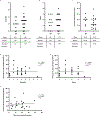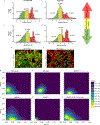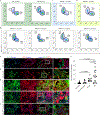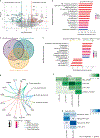Evidence for accelerated aging in mammary epithelia of women carrying germline BRCA1 or BRCA2 mutations
- PMID: 35187501
- PMCID: PMC8849557
- DOI: 10.1038/s43587-021-00104-9
Evidence for accelerated aging in mammary epithelia of women carrying germline BRCA1 or BRCA2 mutations
Abstract
During aging in the human mammary gland, luminal epithelial cells lose lineage fidelity by expressing markers normally expressed in myoepithelial cells. We hypothesize that loss of lineage fidelity is a general manifestation of epithelia that are susceptible to cancer initiation. In the present study, we show that histologically normal breast tissue from younger women who are susceptible to breast cancer, as a result of harboring a germline mutation in BRCA1, BRCA2 or PALB2 genes, exhibits hallmarks of accelerated aging. These include proportionately increased luminal epithelial cells that acquired myoepithelial markers, decreased proportions of myoepithelial cells and a basal differentiation bias or failure of differentiation of cKit+ progenitors. High-risk luminal and myoepithelial cells are transcriptionally enriched for genes of the opposite lineage, inflammatory- and cancer-related pathways. We have identified breast-aging hallmarks that reflect a convergent biology of cancer susceptibility, regardless of the specific underlying genetic or age-dependent risk or the associated breast cancer subtype.
Conflict of interest statement
Competing interests The authors declare no competing interests.
Figures









Comment in
-
Remaining true to one's identity.Nat Aging. 2021 Sep;1(9):757-759. doi: 10.1038/s43587-021-00113-8. Nat Aging. 2021. PMID: 37117630 Free PMC article.
References
-
- Rate of New Female Breast Cancers, United States, 2018 (CDC, 2018); https://gis.cdc.gov/Cancer/USCS/#/AtAGlance/
-
- Kuchenbaecker KB et al. Risks of breast, ovarian, and contralateral breast bancer for BRCA1 and BRCA2 mutation carriers. J. Am. Med. Acad 317, 2402–2416 (2017). - PubMed
-
- Sternlicht MD & Barsky SH The myoepithelial defense: a host defense against cancer. Med. Hypotheses 48, 37–46 (1997). - PubMed
Publication types
MeSH terms
Substances
Grants and funding
- R01 CA192914/CA/NCI NIH HHS/United States
- P20 CA242619/CA/NCI NIH HHS/United States
- R01 CA237602/CA/NCI NIH HHS/United States
- R01 CA234496/CA/NCI NIH HHS/United States
- U01 CA244109/CA/NCI NIH HHS/United States
- R01 CA170851/CA/NCI NIH HHS/United States
- R01 EB024989/EB/NIBIB NIH HHS/United States
- U01 CA189283/CA/NCI NIH HHS/United States
- P30 CA033572/CA/NCI NIH HHS/United States
- R33 AG059206/AG/NIA NIH HHS/United States
- P20 CA242620/CA/NCI NIH HHS/United States
- U54 CA285116/CA/NCI NIH HHS/United States
- T32 CA221709/CA/NCI NIH HHS/United States
LinkOut - more resources
Full Text Sources
Medical
Research Materials
Miscellaneous

